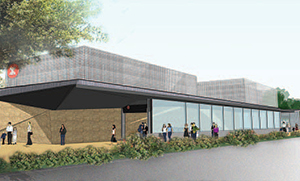
A subsidiary of India's Punj Lloyd Group has won its first order in Hong Kong to construct MTR Corp.'s Shatin to Central Link Diamond Hill Extension Station, located in northern Kowloon. The firm's Hong Kong-based unit, Sembawang Engineers and Constructors, has won the $212-million job with consortium partner Leader Civil Engineering Corp. Ltd.
The 17-kilometer Shatin to Central Link (SCL) is part of Hong Kong's strategic infrastructure plan to develop a railway network to meet its fast-growing future transport needs. Estimated to cost $8.3 billion and split into 10 main contracts, the plan includes building 12 km of new tunnels, four new stations and reconfiguring two interconnecting stations. The work will link several existing railway lines to form strategic north-south and east-west corridors in the region.
Work on the station is scheduled to start in the first quarter of 2013. The scope includes the relocation of heritage structures and archaeological diggings required to facilitate the site; construction of a 250-meter-long, 30-m-deep underground station and connecting junction adits to the existing station; and coordination with interfacing railway operating systems and specialty contractors.
"Modifications to the adjacent existing live station will also be required to aid the flow of passengers," says Richard Grosvenor, president and CEO of Sembawang.
The existing Diamond Hill Station consists of an island platform and the east-bound and west-bound tracks of the Kwun Tong Line (KTL). It will become the interchange station between SCL and KTL. Due to terrain challenges, the existing alignment of the KTL and the location of the proposed station extension, part of the route will be laid below grade, encased with concrete and designed to blend in with the surroundings.
Since the SCL cuts across developed urban areas, most of the tunnels and station—including Diamond Hill—will be constructed underground. Drill-and-blast, cut-and-cover, tunnel-boring and immersed-tube methods, among others, will be adopted depending on factors including topography and geology, says MTR. In soft or mixed-ground conditions near Diamond Hill, where the drill-and-blast method is not feasible, excavation will be carried out by a tunnel-boring machine (TBM) that can simultaneously excavate, remove the spoil and install the concrete segmental lining.
The new station also requires a 30-m-deep excavation adjacent to the existing station but separated by a busy highway.
"The challenge is to construct this excavation and limit associated ground deformations that could affect the existing station and live railway and other adjacent structures," says Chiam Soon Kiam, spokesman for Sembawang.
In addition, at Diamond Hill, SCL will pass below historic buildings, including three significant structures that will need to be temporarily dismantled and relocated during the project's construction. Based on studies carried out by heritage experts, MTR will reassemble the buildings and incorporate them into the railway's design. A preliminary structural assessment has shown that the steel frame of one building—called the Royal Air Force hangar—has corroded badly.
"Part of the frame has already collapsed, while asbestos was found in the structure of the hangar as well as the ceiling of the stone house, so it will be impossible to restore [them] to their former glory," reports an MTR study.
In October, France-based Vinci started work under a contract to build a 4-km route on the SCL. Estimated to cost $374.4 million, the work includes 2,475 m of drill-and-blast tunnels and 1,400 m of twin tunnels excavated using a 7.4-m-dia slurry TBM. The job is scheduled for 68 months.
Sembawang previously has executed light-rail and mass-rapid-transit projects in Singapore, including three-story stations, elevated and underground routes, and rail depots.

Post a comment to this article
Report Abusive Comment